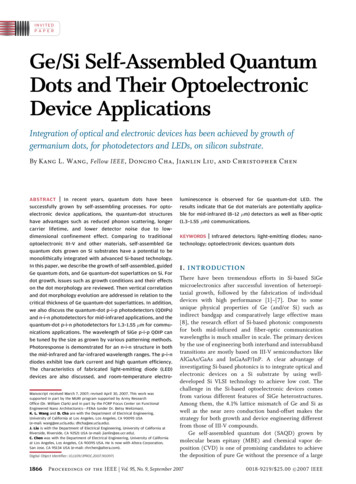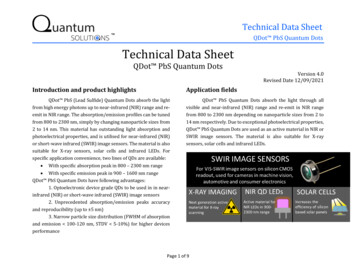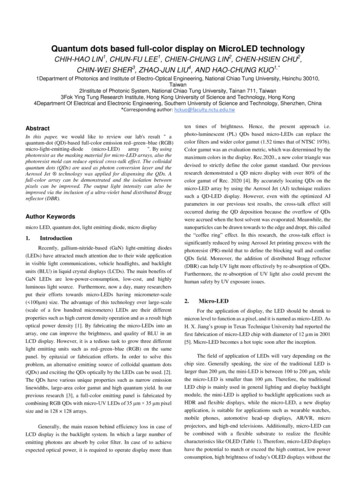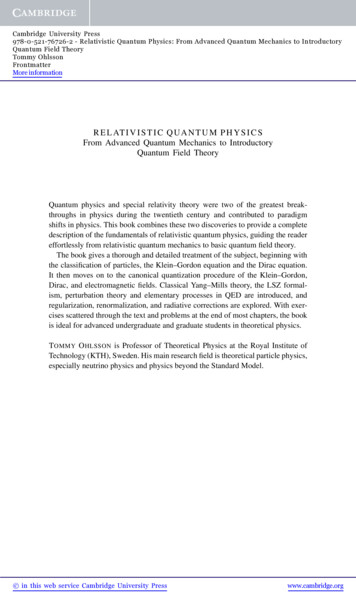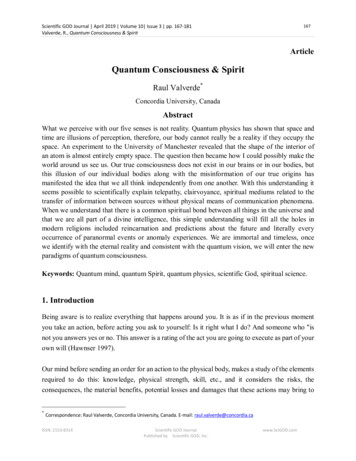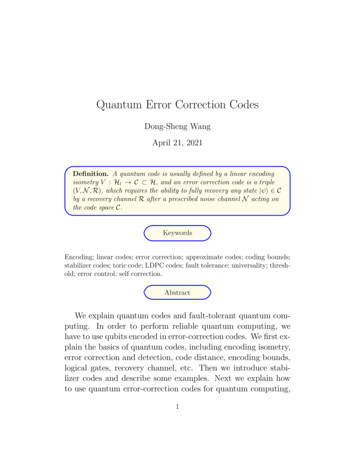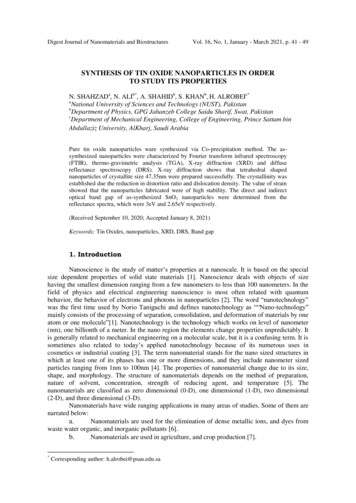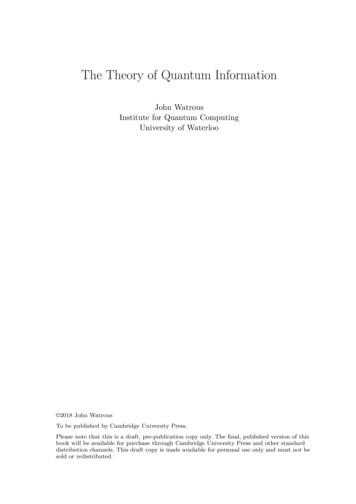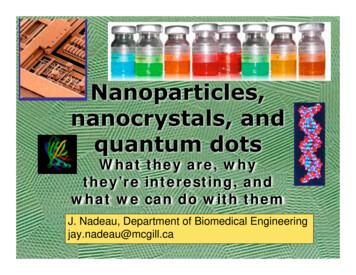
Transcription
Nanoparticles,nanocrystals, andquantum dotsWhat they are, whythey’re interesting, andwhat we can do with themJ. Nadeau, Department of Biomedical Engineeringjay.nadeau@mcgill.ca
Colloidal nanocrystals of different materials
And differentgeometriesFrom: Science. 2005 January 28;307(5709): 538 544.
Medieval Nanotechnology!The colors in some stainedglass windows frommedieval cathedrals areprobably due to nanocrystalsof compouds of Zn, Cd, S,and Se.
History of nanoparticles1980 Ekimov observed quantum confinement on a sample of glasscontaining PbS.1982 Brus L.’s group conducted CdS colloid preparation and investigationof band-edge luminescence properties.1993 Murray C., Norris D., Bawendi M., Synthesis and Characterization ofNearly Monodisperse CdE (E S, Se, Te) Semiconductor Nanocrystallites.1995 Hines M., Guyot-Sionnest P., reported synthesis and Characterizationof Strongly Luminescent ZnS-Capped CdSe Nanocrystals1998 Alivisatos and Nie independently reported Bio-application for coreshell dots.2001 Nie’s group described Quantum dot-tagged microbeads formultiplexed optical coding of biomolecules.2003 T. Sargent at UOT observed electroluminescence spanning 1000 – 1600nm originating from PbS nanocrystals embedded in a polymer matrix.
What is a quantum dot? Synthesis Quantum mechanics Optical propertiesWhat is it good for? Interesting physics Applications in optoelectronics Applications in biology
Synthesis
Quick review ofsemiconductors A semiconductor has a forbiddenzone or “band gap” between theconduction and valence band When an electron is excited into theconduction band, there is a hole leftin the valence band; this pair is an“exciton pair” When the size of the crystal iscomparable to the exciton Bohrradius, the confinement energybecomes signficant at this pointwe have a “quantum dot”
Quantum mechanics of QDsh 2 2nlEe E gap( )2m *e–h2 2nlEh 2m *heEnergy0 E CB m *h * 3.2 (wurzite ) E VB m eh Bulk CdSeQ dotBecause of these quantized energylevels, QDs are more like atoms thanlike bulk materials--earning them thename “artificial atoms”
This is anoversimplification “Box” wells are not infinite Particles aren’t spherical Boundary conditions must beconsidered We assume only a singleelectron However--the approximation issurprisingly good!
Size-dependent spectraTemporal evolution ofCdSe nanocrystals2.3 nm (5 s)0.382.6 nm (20 s)3.0 nm ( 1 min)A3.3 nm (1.5 min)3.6 nm (2 min)4.2 nm (30min,rt)0.18-0.02300350400450500 550WL/nm600650700
Emission250CdSe nanocrystals2.7 nm 3.0 nm 3.2 nm 3.6 nmIntensity200150100500450500550Wavelength (nm)600650
CharacterizationAFM image of a cluster of CdSe nanocrystals(3.3 nm). Image size 70nm x70 nm
HR TEM shows latticestructure
So what is it good for?CdSe, CdS,ZnS,CdTe,etcNormalized intensities3 to 10 nm Slow to photobleach and radiationresistant Emission can be quenched/modulated byattaching electron donors or acceptors tothe surface1 Can be suspended in aqueous and nonaqueous environmentsAbsorptionEmission Many colors obtained with a single UVexcitation source0450 Emission wavelength is related to the sizeof the crystal500550600 (nm)650700 Surface can be conjugated to chemicallyand biologically important molecules
Interesting physics! Trap statesStokes shiftStark EffectBlinking
The importance of surface statesMore than half the atoms areat the surface
How to probe surface statesTransient absorption spectroscopyElectron and holeacceptors quench PL PL results fromexciton recombinationBurda et al, J. Phys. Chem. B, 105 (49),12286 -12292, 2001
What causes the Stokesshift? Exciton fine structure Independent of surfaceNorris and Bawendi, JOURNAL OF CHEMICAL PHYSICS 103 (13): 5260-5268 OCT 1 1995
Blinking
“On” and “off” states Many groups have found that “off” states follow a powerlaw “On” times more controversial; perhaps power law,perhaps power law convoluted with exponential
Two Models Fluctuating distribution of electron traps in theimmediate vicinity of, but external to, the QD.Tunneling of the electron out of the QD resultsin a charged particle, quenching emission(Kuno et al. 2003, Phys. Rev. B 67, 125304). Internal hole traps, presumably at surfacestates or crystal imperfection sites. Energeticdiffusion of the electronic states results in atime-dependent resonance condition in whichAuger-assisted trapping of the hole results inan off state (Frantsuzov and Marcus 2005, Phys.Rev. B 72, 155321)
Stark Effect Shift in energy with electric field Permanent dipole moment:dependence as E Polarizability: as E2 QDs show both aspects, but Edependence is only seen in singledot studies (not ensembles)Empedocles and Bawendi, Science 19 December 1997: Vol. 278. no. 5346, p 2114
Uses of Stark EffectBecker et al., Nature Materials 5, 777 - 781 (2006)
Interestingapplications! Biological labelsSingle-particle trackingBiosensorsMemorySolar cellsEtc
Biological labeling: neurons and gliaPathak, S. et al. J. Neurosci. 2006;26:1893-1895Copyright 2006 Society for Neuroscience
Single-particle trackingFrom: Science. 2005 January 28;307(5709): 538 544.
QDs as biosensorsDopamineDoxorubicin (adriamycin)
QD-dopamine as aredox sensorEnergyCBO, Rh VBDopamine is an excellent electron donorh OR
Normal conditions
Reducing conditions
Uptake into cells
With antioxidants
Redox dependence
More oxidizing Addition of theglutathionesynthesis inhibitorBSO (10 mM)affects theintracellular redoxpotential withoutaltering that ofthe medium
Or more reducing
Photoenhancement
Quantum dot memoryAPPLIED PHYSICS LETTERS 86 (19): Art. No. 193106 MAY 9 2005
Summary QDs allow us to observe atomicphysics at the almost macroscopicscale However, there are alwayscomplications due to surface states,solvent interactions, etc that makethem more than a particle in a box A lot has been done, but a lot moreremains to be done before weunderstand these particles and canuse them in complex media
Les incontournables1. Aldana, J., Wang, Y.A. & Peng, X.G. Photochemical instability of CdSe nanocrystals coated by hydrophilic thiols. Journal of theAmerican Chemical Society 123, 8844-8850 (2001).2.Burda, C., Green, T.C., Link, S. & El-Sayed, M.A. Electron shuttling across the interface of CdSe nanoparticlesmonitored by femtosecond laser spectroscopy. Journal of Physical Chemistry B 103, 1783-1788 (1999).3.Chan, W.C. & Nie, S. Quantum dot bioconjugates for ultrasensitive nonisotopic detection. Science 281, 2016-2018.(1998).4.Cho, S.J. et al. Long-term exposure to CdTe quantum dots causes functional impairments in live cells. Langmuir 23,1974-1980 (2007).5.Derfus, A.M., Chan, W.C.W. & Bhatia, S.N. Probing the cytotoxicity of semiconductor quantum dots. Nano Letters 4,11-18 (2004).6.Empedocles, S.A. & Bawendi, M.G. Quantum-confined stark effect in single CdSe nanocrystallite quantum dots.Science 278, 2114-2117. (1997).7.Empedocles, S.A., Norris, D.J. & Bawendi, M.G. Photoluminescence Spectroscopy of Single CdSe NanocrystalliteQuantum Dots. Physical Review Letters 77, 3873-3876. (1996).8.Hagfeldt, A. & Gratzel, M. Light-Induced Redox Reactions in Nanocrystalline Systems. Chemical Reviews 95, 49-68(1995).9.Haram, S.K., Quinn, B.M. & Bard, A.J. Electrochemistry of CdS nanoparticles: A correlation between optical andelectrochemical band gaps. Journal of the American Chemical Society 123, 8860-8861 (2001).10.Bruchez, M., Jr., Moronne, M., Gin, P., Weiss, S. & Alivisatos, A.P. Semiconductor nanocrystals as fluorescentbiological labels. Science 281, 2013-2016 (1998).11.Klimov, V.I. et al. Optical gain and stimulated emission in nanocrystal quantum dots. Science 290, 314-317. (2000).12.Murray, C.B., Norris, D.J. & Bawendi, M.G. Synthesis and Characterization of Nearly Monodisperse Cde (E S, Se,Te) Semiconductor Nanocrystallites. Journal of the American Chemical Society 115, 8706-8715 (1993).13.Dabbousi, B.O. et al. (CdSe)ZnS core-shell quantum dots: Synthesis and characterization of a size series of highlyluminescent nanocrystallites. Journal of Physical Chemistry B 101, 9463-9475 (1997).14.Leatherdale, C.A. & Bawendi, M.G. Observation of solvatochromism in CdSe colloidal quantum dots. Physical ReviewB 6316, art. no.-165315 (2001).15.Nirmal, M. et al. Observation of the Dark Exciton in Cdse Quantum Dots. Physical Review Letters 75, 3728-3731(1995).16.Shimizu, K.T. et al. Blinking statistics in single semiconductor nanocrystal quantum dots. Physical Review B 63,205316 (2001).17.Kuno, M., Fromm, D.P., Hammann, H.F., Gallagher, A. & Nesbitt, D.J. Nonexponential "blinking" kinetics of singleCdSe quantum dots: A universal power law behavior. Journal of Chemical Physics 112, 3117-3120 (2000).
To come Toxicity Stability and alternativecoatings Metal particles Insulator particles
glass windows from medieval cathedrals are probably due to nanocrystals of compouds of Zn, Cd, S, and Se. Medieval Nanotechnology! History of nanoparticles . Quantum mechanics of QDs E e h2 nl 2 2m e* E gap( ) E h -h2 nl 2 2m h* E CB EVB m h* m e* 3.2 (wurzite) Bulk CdSe Q dot Energy 0 h e-
